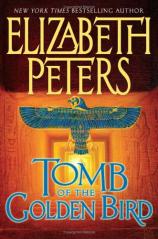Tomb of the Golden Bird
Review
Tomb of the Golden Bird
The year is 1922, and renowned archaeologists Amelia Peabody
Emerson and her irascible husband, known simply as Emerson, have
arrived at their home in the Valley of the Kings, eager to follow
up on their discovery of the year before. Readers may remember the
tantalizing find of a tiny jeweled serpent thought to be from the
tomb of Tutankhamon, which was featured in THE SERPENT ON THE
CROWN. Possession of the priceless ornament nearly cost Amelia her
life, but she is back on her feet, indomitable as ever, and she and
her entourage are hot on the trail of the elusive tomb.
The famous tale of the discovery of the most famous tomb in all of
Egypt has been told many times. The real discoverers and
benefactors of the riches within are all a part of history, so of
course Peters can't have Amelia, Emerson, their son Ramses, and his
wife Nefret actually discover the tomb. Or can she? Emerson has
always suspected a specific mound as the tomb site, but since
strict international laws dictate where an archaeologist can work,
any discovery must be credited to the license holder of the area.
Much to Emerson's dismay and frustration, the rights to the site
belong to an aging antiquities collector, Lord Carnarvon, who is
purported to be giving up his rights to the site. Emerson longs to
attain the license, but Carnarvon decides to give his expedition
one more year, so Emerson can do nothing but look on in envy. He
succeeds in insulting the chief excavator to the extent that he and
his group are banned from the site. That does not keep the
industrious group from finding ingenious ways to enter the
tomb.
Meanwhile, the treacherous Sethos, Emerson's secret agent
half-brother, becomes an unwelcome guest at the villa. He arrives
in the deep of night, suffering from malaria and carrying a stolen
encoded message from a band of political revolutionaries that he
hopes Ramses, a code specialist, can unravel. The Middle East is in
turmoil at the end of World War I, and Iraq and Egypt are still
ruled by kings. Revolutionary forces from all sides, funded by
wealthy industrialists with a thirst for oil, are attracting local
thugs to do their dirty work, and Sethos, as usual, is in the thick
of it.
Perhaps the most political of Amelia's adventures, THE TOMB OF THE
GOLDEN BIRD offers delightful insights into the opening and
cataloging of the tons of gold and antiquities from the glorious
tomb of King Tut. The discovery of this tomb signals the beginning
of the end of the great explorations in the Valley of the Kings.
The auto is supplanting donkeys and horses as transportation.
Electric lights erase the shadows from tombs once lit by torches.
It is the end of one era and the beginning of another. The first
salvos are being fired in the unrest that, to this day, embroils
that part of the world in relentless wars.
Elizabeth Peters holds a PhD in Egyptology and is a recognized
authority on the great dynasties of Ancient Egypt. She does not
claim to be a political expert, but she seems to have a firm grasp
of the political, religious and cultural conflicts of that region
in those times.
This is the 18th Amelia Peabody mystery, covering over 30 years in
the lives of the romantic adventurers. They are still in love ---
with each other, with archaeology and with Egypt. Will Amelia and
Emerson return for further adventures? If there are more intrigues
to resolve and more tombs to explore, the Emersons will live
on.
Reviewed by Roz Shea on January 23, 2011





